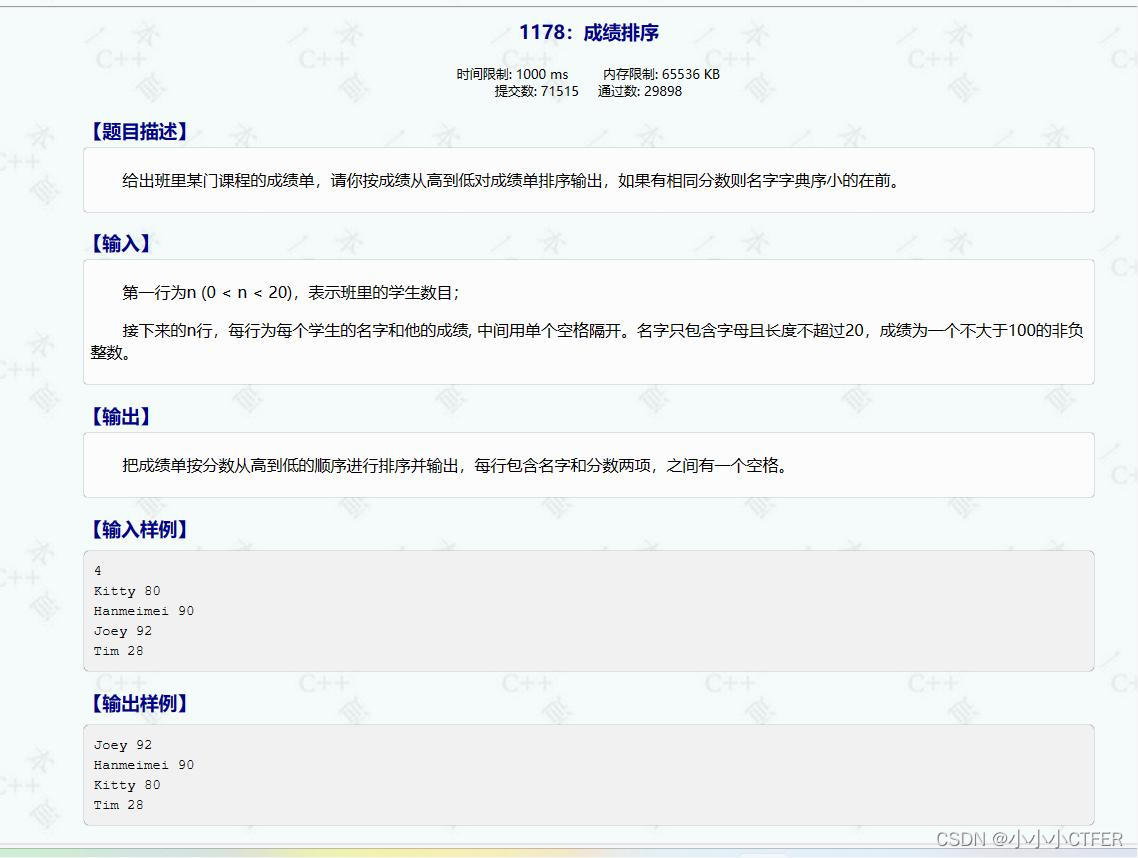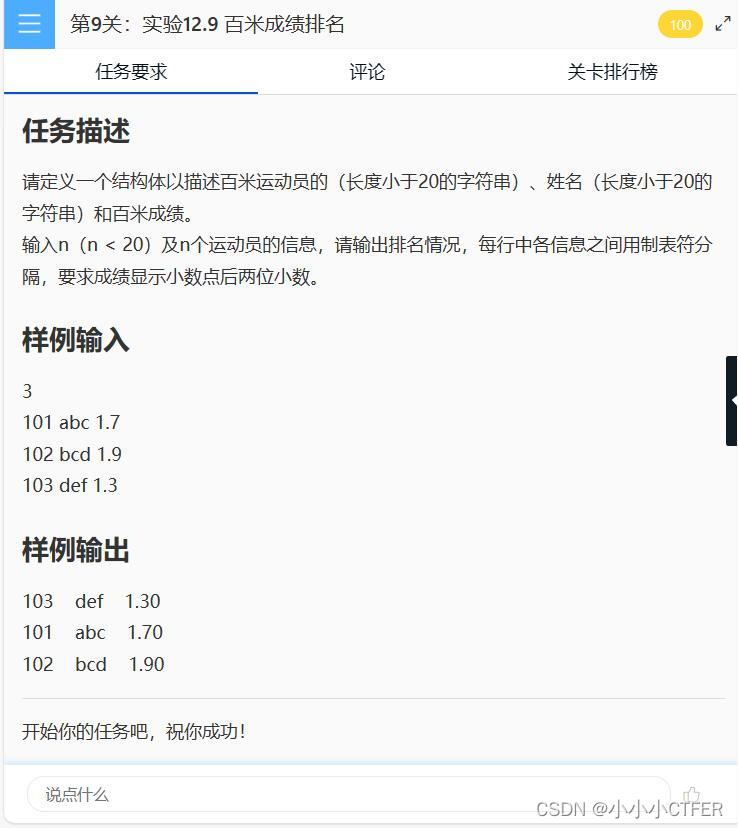了解结构体以及结构体数组
发布时间:2024年01月11日
C语言的结构体你真的了解吗?? ?一起来看一下吧!!!
1.结构体是啥?
? ? ? ? ? 结构体是多种数据类型的组合体
2.格式(一般放在主函数前,也就是int main()前面 )
关键字 结构体名字 {成员列表}
sturct 结构体名字 {成员列表}
//例如
struct date{
int year;
int month; // 类型名 + 成员名
int day;
}; // !!!不要忘记这里的‘;’3.简单结构体展示
#include <bits/stdc++.h>
using namespace std;
struct date{
int year;
int month;
int day;
};
int main(){
struct date today; //定义结构体变量
today.year = 2024; // 输入结构体成员的值(!!!法一)
today.month = 1;
today.day = 10;
printf("today is %d.%02d.%02d",today.year,today.month,today.day);
// %02d 是将不足两位的补零
return 0;
}运行结果:
today is 2024.01.10
声明两个日期(声明变量):
法一:(注意today,tomoorrow;位置)
#include <bits/stdc++.h>
using namespace std;
struct date{
int year;
int month;
int day;
}today,tomoorrow; //在在在在在在在这声明了两个日期,后面可以直接用了
int main(){
today.year = 2024; // 输入结构体成员的值
today.month = 1;
today.day = 10;
struct date tomorrow = {.year = 2024,.month = 1,.day = 11 };
printf("today is %d.%02d.%02d\n",today.year,today.month,today.day);
printf("tomorrow is %d.%02d.%02d",tomorrow.year,tomorrow.month,tomorrow.day);
// %02d 是将不足两位的补零
return 0;
}法二:
#include <bits/stdc++.h>
using namespace std;
struct date{
int year;
int month;
int day;
};
int main(){
struct date today,tomoorrow; //在在在在在在在这声明了两个日期
today.year = 2024; // 法法法111输入结构体成员的值
today.month = 1;
today.day = 10;
struct date tomorrow = {.year = 2024,.month = 1,.day = 11 };
//法法法222输入输入结构体成员的值
printf("today is %d.%02d.%02d\n",today.year,today.month,today.day);
printf("tomorrow is %d.%02d.%02d",tomorrow.year,tomorrow.month,tomorrow.day);
// %02d 是将不足两位的补零
return 0;
}运行结果:
today is 2024.01.10
tomorrow is 2024.01.11先不要着急,为什么看不懂,前两个代码的运行和结果让你先看看结构体,看看就行,有个了解
4.上题目:实践起来

5.代码:
#include <bits/stdc++.h>
using namespace std;
struct student {
string name;
int g;
}a[25]; //定义结构体
bool cmp(student x,student y){
if (x.g == y.g) return x.name < y.name; //如果结构体中x的成绩与y的成绩一样,就比较名字的首字母字典排序
else return x.g>y.g;} // 找出结构体中成绩高的
int main()
{
int n;
cin >> n;
for(int i=0;i<n;i++)
{
cin>>a[i].name>>a[i].g; //输入结构体成员的值
}
sort(a,a+n,cmp); //sort排序
for(int i=0;i<n;i++)
{
cout<<a[i].name<<" "<<a[i].g<<endl; //输出结构体
}
return 0;
}6.主要知识点:
? ? ? ?(1)怎样写结构体的cmp函数;
bool cmp(student x,student y){ //类型很重要,这里用结构体的类型
if (x.g == y.g) return x.name < y.name; //如果结构体中x的成绩与y的成绩一样,就比较名字的首字母字典排序
else return x.g>y.g;} // 找出结构体中成绩高的 ? ? ? (2)cmp的字典排序:
因为return x.g>y.g返回的是倒序,这个字母大小是按ascll码排序的?所以要用
return x.name < y.name //因为name是字符,不用考虑其他的东西? ?(3)输入结构体成员:(输出同理)
int n;
cin >> n;
for(int i=0;i<n;i++)
{
cin>>a[i].name>>a[i].g; //输入结构体成员的值
}7.来再刷一道题,巩固巩固刚刚学到的知识
? ? ? ? ? ? ? ?题目:

? ? ? ? ? ? ? 代码:?
#include <bits/stdc++.h>
using namespace std;
struct stu{
string x;
string y;
double z;
}a[25];
bool cmp(stu a,stu b)
{
return a.z<b.z;
}
int main()
{
int n;
cin>>n;
for(int i=0;i<n;i++)
{
cin>>a[i].x>>a[i].y>>a[i].z;
}
sort(a,a+n,cmp);
for(int i=0;i<n;i++)
cout<<a[i].x<<"\t"<<a[i].y<<"\t"<<fixed<<setprecision(2)<<a[i].z<<endl;
return 0;
}100.补充:使用typedef 简化结构体
? ? ? ? 每次定义时都要输入struct? 结构体名字? ?xxx;我们想办法让他简单一点,就使用typedef函数,因为时间原因,作为码农的你去收集资料弄懂吧!!!
文章来源:https://blog.csdn.net/2301_80284843/article/details/135505860
本文来自互联网用户投稿,该文观点仅代表作者本人,不代表本站立场。本站仅提供信息存储空间服务,不拥有所有权,不承担相关法律责任。 如若内容造成侵权/违法违规/事实不符,请联系我的编程经验分享网邮箱:chenni525@qq.com进行投诉反馈,一经查实,立即删除!
本文来自互联网用户投稿,该文观点仅代表作者本人,不代表本站立场。本站仅提供信息存储空间服务,不拥有所有权,不承担相关法律责任。 如若内容造成侵权/违法违规/事实不符,请联系我的编程经验分享网邮箱:chenni525@qq.com进行投诉反馈,一经查实,立即删除!
最新文章
- Python教程
- 深入理解 MySQL 中的 HAVING 关键字和聚合函数
- Qt之QChar编码(1)
- MyBatis入门基础篇
- 用Python脚本实现FFmpeg批量转换
- 鸭厂养殖废水处理厂家解决方案
- 文心、讯飞、ChatGPT大模型横向比较
- JavaWeb编程语言—登录校验
- 扭蛋机小程序搭建,又一个新的“赚钱赛道”出现了
- Redis内存策略
- linux shell脚本开发基础操作汇总
- 14:00面试,14:08就出来了,问的问题有点变态。。。
- LabVIEW交变配流泵性能测试系统
- k8s---HPA
- 私有云盘用户系统的设计与实现(JSP+java+springmvc+mysql+MyBatis)